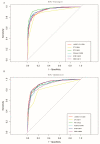Applications of Machine Learning to Diagnosis of Parkinson's Disease
- PMID: 38002506
- PMCID: PMC10670005
- DOI: 10.3390/brainsci13111546
Applications of Machine Learning to Diagnosis of Parkinson's Disease
Abstract
Background: Accurate diagnosis of Parkinson's disease (PD) is challenging due to its diverse manifestations. Machine learning (ML) algorithms can improve diagnostic precision, but their generalizability across medical centers in China is underexplored.
Objective: To assess the accuracy of an ML algorithm for PD diagnosis, trained and tested on data from different medical centers in China.
Methods: A total of 1656 participants were included, with 1028 from Beijing (training set) and 628 from Fuzhou (external validation set). Models were trained using the least absolute shrinkage and selection operator-logistic regression (LASSO-LR), decision tree (DT), random forest (RF), eXtreme gradient boosting (XGboost), support vector machine (SVM), and k-nearest neighbor (KNN) techniques. Hyperparameters were optimized using five-fold cross-validation and grid search techniques. Model performance was evaluated using the area under the curve (AUC) of the receiver operating characteristic (ROC) curve, accuracy, sensitivity (recall), specificity, precision, and F1 score. Variable importance was assessed for all models.
Results: SVM demonstrated the best differentiation between healthy controls (HCs) and PD patients (AUC: 0.928, 95% CI: 0.908-0.947; accuracy: 0.844, 95% CI: 0.814-0.871; sensitivity: 0.826, 95% CI: 0.786-0.866; specificity: 0.861, 95% CI: 0.820-0.898; precision: 0.849, 95% CI: 0.807-0.891; F1 score: 0.837, 95% CI: 0.803-0.868) in the validation set. Constipation, olfactory decline, and daytime somnolence significantly influenced predictability.
Conclusion: We identified multiple pivotal variables and SVM as a precise and clinician-friendly ML algorithm for prediction of PD in Chinese patients.
Keywords: Parkinson’s disease; diagnostic accuracy; external validation; machine learning; support vector machine.
Conflict of interest statement
The authors declare no conflict of interest.
Figures



Similar articles
-
A Risk Prediction Model for Physical Restraints Among Older Chinese Adults in Long-term Care Facilities: Machine Learning Study.J Med Internet Res. 2023 Apr 6;25:e43815. doi: 10.2196/43815. J Med Internet Res. 2023. PMID: 37023416 Free PMC article.
-
[Construction of a predictive model for in-hospital mortality of sepsis patients in intensive care unit based on machine learning].Zhonghua Wei Zhong Bing Ji Jiu Yi Xue. 2023 Jul;35(7):696-701. doi: 10.3760/cma.j.cn121430-20221219-01104. Zhonghua Wei Zhong Bing Ji Jiu Yi Xue. 2023. PMID: 37545445 Chinese.
-
Machine learning-based prediction of hospital prolonged length of stay admission at emergency department: a Gradient Boosting algorithm analysis.Front Artif Intell. 2023 Jul 28;6:1179226. doi: 10.3389/frai.2023.1179226. eCollection 2023. Front Artif Intell. 2023. PMID: 37588696 Free PMC article.
-
Development of a machine learning model related to explore the association between heavy metal exposure and alveolar bone loss among US adults utilizing SHAP: a study based on NHANES 2015-2018.BMC Public Health. 2025 Feb 4;25(1):455. doi: 10.1186/s12889-025-21658-y. BMC Public Health. 2025. PMID: 39905341 Free PMC article.
-
Predicting adverse drug event using machine learning based on electronic health records: a systematic review and meta-analysis.Front Pharmacol. 2024 Nov 13;15:1497397. doi: 10.3389/fphar.2024.1497397. eCollection 2024. Front Pharmacol. 2024. PMID: 39605909 Free PMC article.
Cited by
-
The Effect of Data Leakage and Feature Selection on Machine Learning Performance for Early Parkinson's Disease Detection.Bioengineering (Basel). 2025 Aug 6;12(8):845. doi: 10.3390/bioengineering12080845. Bioengineering (Basel). 2025. PMID: 40868358 Free PMC article.
-
Parkinson's Disease is Predominantly a Genetic Disease.J Parkinsons Dis. 2024;14(3):467-482. doi: 10.3233/JPD-230376. J Parkinsons Dis. 2024. PMID: 38552119 Free PMC article. Review.
-
Exploring the Potential Imaging Biomarkers for Parkinson's Disease Using Machine Learning Approach.Bioengineering (Basel). 2024 Dec 27;12(1):11. doi: 10.3390/bioengineering12010011. Bioengineering (Basel). 2024. PMID: 39851285 Free PMC article.
-
Multimodal diagnostic tools and advanced data models for detection of prodromal Parkinson's disease: a scoping review.BMC Med Imaging. 2025 Mar 28;25(1):103. doi: 10.1186/s12880-025-01620-5. BMC Med Imaging. 2025. PMID: 40155878 Free PMC article.
References
Grants and funding
LinkOut - more resources
Full Text Sources

